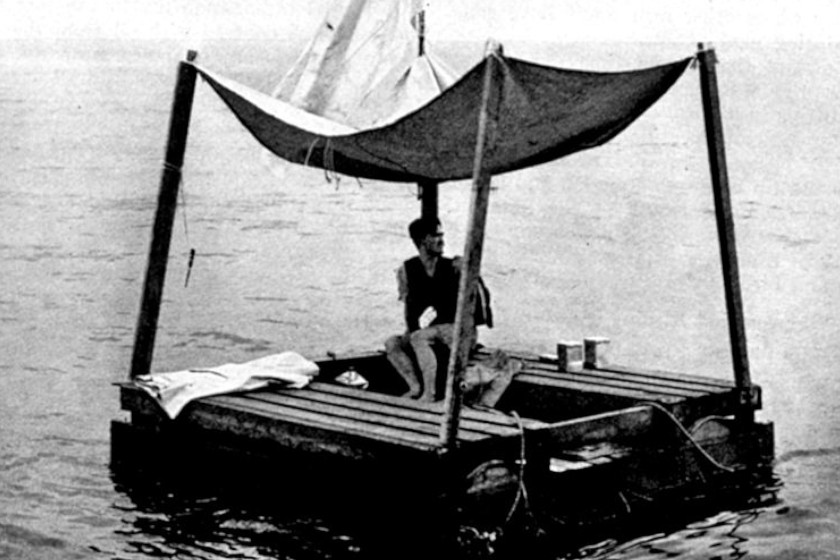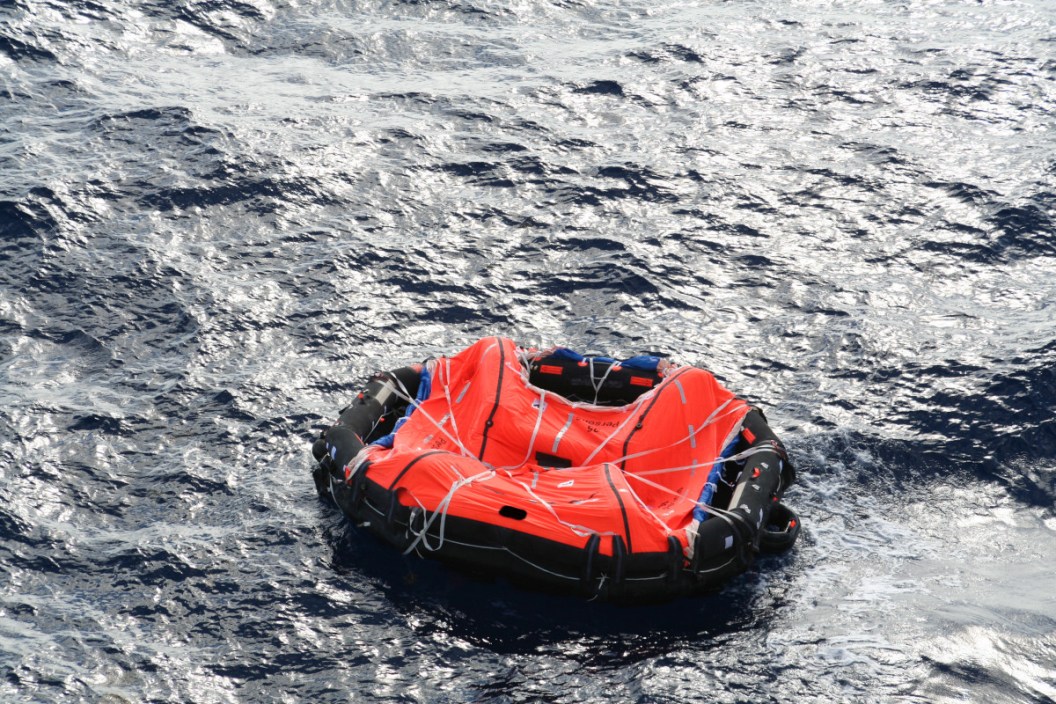These sea survival stories are nothing short of incredible.
When it comes to survival situations, perhaps the worst one to find yourself in is being lost at sea. Getting marooned on an uncharted island like Tom Hanks in "Castaway," isn't very likely. Most real-life survival stories involve someone stuck in a small boat or life raft after a shipwreck with no way to control their movements in the open oceans.
These sorts of situations have extremely low survival odds, mostly because survivors often have a lack of food supplies and fresh water. Finding either in the ocean can be difficult if not impossible.
If that wasn't bad enough, visibility on the ocean is often terrible. The unpredictable currents and weather can throw someone adrift hundreds of miles away from where they were originally wrecked. As a result, your odds of rescue are equally minuscule, because spotting someone adrift on the open ocean is like trying to find a needle in a haystack, even with a ship riding high on the water. Even helicopters and airplanes can have a hard time spotting someone in that situation.
There are some extremely famous stories out there of people who defied all odds to survive on the open ocean. Their stories are a great lesson on what to do and what not to do if you're ever unfortunate enough to find yourself in a similar scenario.
Here are five of the most famous true sea survival stories ever.
Steven Callahan, 76 days at sea
In 1981, Rhode Island resident Steven Callahan felt like his life was falling apart and he wanted an escape. Following a divorce from his wife, he constructed a 21-foot ship called the Napoleon Solo to do just that: sail the seas solo, without anyone else around. He left Newport, Rhode Island for Bermuda and then crossed the Atlantic Ocean to England and Spain. He was near the Canary Islands, which lay off the coast of Africa, when he awoke to a thud in the darkness of night. He believes now it was either a whale or a large shark accidentally bumping the hull. When he stood up he found his small boat was rapidly filling with water.
Callahan threw what supplies he could into a tiny, six-foot life raft. This included a sleeping bag, flare gun, spear gun, food, water, and some survival stills. For the next 76 days, he was at the mercy of the ocean as his raft drifted all the way across the Atlantic, battling storms and leaks the whole way.
During the trip, Callahan survived mostly by fishing, although it took him 14 days to learn how to use the speargun. Still, the fish provided food which he ate raw. One of the fish he speared, a mahi-mahi, nearly sank the raft when its sharp fins pierced the hull. Somehow, Callahan managed to make a patch that held.
He couldn't get the water stills to desalinate ocean water properly, and he was down to his last few cans of water when he was finally spotted by fishermen off the coast of Guadeloupe. He had lost nearly 40 pounds but lived to tell the tale.
Callahan later wrote a book: Adrift: Seventy-Six Days Lost at Sea in 1986, and also served as a consultant on the film "Life of Pi." He stated in a piece with The Guardian that he does not regret the experience and feels it changed his life for the better, even if he never wants to experience it ever again.
Jose Salvador Alvarenga, 438 days at sea

Getty Images: AFP
Alvaregna's tale made worldwide headlines in 2014 because of the unbelievable length of time he was forced to survive on the ocean. Alvarenga and a co-worker, Ezequiel Cordoba, initially left Pijijiapan, Mexico on November 17, 2012, on a fishing trip when a storm hit and blew their small, 23-foot fishing boat off course. They also lost motor and fishing electronics. Alvarenga managed to radio in a distress message to his boss, but the batteries quickly died in the radio.
The tiny boat had a freezer for holding their catch, but the fishermen were forced to dump it in the five-day storm that initially put them in peril. Attempts at a rescue from the mainland were thwarted by low visibility. This meant the men were on their own.
For the next four months, the two men lived on whatever the ocean provided. This was mostly fish, sea birds, and sea turtles. They drank rainwater, but often had to substitute turtle blood and even their own urine. After four months, Ezequiel allegedly became sick and quit eating, having lost the will to live. He eventually died of starvation. It took four days before Alvarenga got the courage to throw him overboard.
From there, Alvarenga continued to drift across the Pacific Ocean. He occasionally spotted large container ships but could not get the attention of anyone onboard. Finally, on January 30, 2014, Alvarenga spotted land, and abandoned his boat to swim to shore where he found help at the nearest beach house. He had washed up on Ebon Atoll in the Marshall Islands, approximately 6,000 miles from where he'd been lost.
Alvarenga returned to his family and home country of El Salvador where he allegedly lives as far away from the water as he can get. We can't say we blame him!
Tami Oldham Ashcraft, 41 days adrift
In 1983, then 23-year-old Tami Lee Oldham Ashcraft set sail from Tahiti with her fiancé, 34-year-old Richard Sharp, in a 36-foot sailboat named the Hazana. They had been hired by the boat's new owner to deliver it to San Diego, California. They left Tahiti on September 22, sailing without incident until October 12. Unfortunately, their boat got caught in 40-foot seas and high winds from Hurricane Raymond, which was a Category 4 storm. During the worst part of the hurricane, Sharp told Ashcraft to go below for safety.
While Sharp was still on deck, the last thing Ashcraft heard from Sharp was him screaming 'Oh my God!' before a large wave threw her against the cabin and knocked her out for 27 hours. When she awoke, her fiancé was gone, lost overboard. Unfortunately, the ship's radio and navigation systems got soaked by seawater as the ship was half sunk. The storm had also taken out the sailboat's masts. She survived mostly on canned goods from the boat's life raft.
Fortunately, Ashcraft had some experience sailing. She was able to jerry-rig a makeshift mast, and once she figured out where she was, she got the boat into the North Equatorial Current, which helped her cover more miles and set a course for Hawaii. Ashcraft has since admitted in interviews, she considered ending her own life the last few days. Luckily, after 41 days adrift, she was finally rescued near Hilo, Hawaii on November 22, 1983.
She later wrote a book on her story of survival and dealing with the grief of losing her fiancé. The book was adopted into the 2018 movie "Adrift" starring Shailene Woodley as Ashcraft.
Louis Jordan, 66 days on a collapsed sailboat
In a more recent survival tale, Louis Jordan set sail from South Carolina on January 23, 2015, on a fishing trip, only to be awakened by his 35-foot boat capsizing in a storm in the middle of the night. The storm snapped his ship's mast and broke his radio and communications equipment, stranding him at sea. The accident also broke his collarbone.
After not hearing from him for a week, Louis' family reported him missing on January 29, but searchers called off the rescue approximately ten days later. For the next 66 days Louis survived on a combination of food that he had on board plus whatever he could catch in a net. He used his dirty laundry to attract the fish close enough to the wrecked vessel to net. Fortunately, he was able to collect and ration out rainwater.
Finally, Louis was spotted approximately 200 miles from shore by a German cargo ship. The Coast Guard airlifted him from the ship back to dry land where he called his family to announce the good news of his rescue himself. It's worth noting that Louis admitted he was not an experienced sailor. He had told no one where he planned on going, which is why search crews could not narrow down where he was. His story is a reminder to always tell someone where you are going when hitting the open ocean!
Poon Lim, 133 days on a raft

Wikimedia Commons: Unknown Author
Lim was originally born in China but served on an armed British merchant ship U172 during World War II. On the night of November 23, 1942, the ship was off the coast of Brazil while on route to South Africa when a German U-boat hit the U172 with two torpedoes. The damage to the ship was so catastrophic that the U172 went down in only two minutes approximately 250 miles from shore. Most of the crew members did not have time to escape.
Lim was one of only six to get out in time. He jumped overboard with only a lifejacket. The currents of the Atlantic Ocean soon separated the group and Lim was on his own when he came across a life raft made of wood from the ship. Fortunately for Lim, there were some food supplies on board, mostly biscuits but also 11 gallons of water, some chocolate, and a flashlight. Of course, these supplies didn't last long.
He was soon forced to catch rainwater using a jacket. He also fashioned makeshift fishhooks out of nails and wire from the flashlight. This helped him to catch some of the sharks that started to circle his raft for food. He also captured and killed birds, once drinking its blood to keep himself from being dehydrated.
The war did Lim no favors in this true story. He was spotted by U.S. Navy planes and passing freighters more than once. The Navy was blocked from rescuing Lim due to a storm and the ships were too cautious to approach, mostly because the German Navy had a reputation for staging such scenes. It helped make the ships easy targets for the U-boats. Lim was spotted by a German submarine too, which promptly ignored him.
Finally, on April 5, 1943, Lim drifted ashore in Brazil and was rescued by some fishermen. He had spent 133 days at sea, a world record for someone stranded on a life raft.
Unfortunately, Lim was the only survivor of the U172 and was given medals after the fact. Many of his survival techniques were later incorporated into training for sailors. Lim later became a U.S. citizen and lived out his days in the states.
For more outdoor content from Travis Smola, be sure to follow him on Twitter and Instagram For original videos, check out his Geocaching and Outdoors with Travis YouTube channels.
READ MORE: 3-YEAR-OLD SAYS HE 'HUNG OUT WITH A BEAR' WHILE STRANDED FOR 2 DAYS IN THE WOODS




